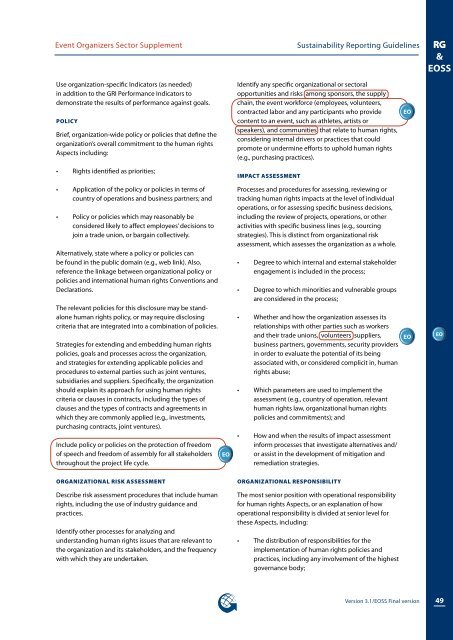Event Organizers Sector Supplement - Global Reporting Initiative
Event Organizers Sector Supplement - Global Reporting Initiative
Event Organizers Sector Supplement - Global Reporting Initiative
Create successful ePaper yourself
Turn your PDF publications into a flip-book with our unique Google optimized e-Paper software.
<strong>Event</strong> <strong>Organizers</strong> <strong>Sector</strong> <strong>Supplement</strong><br />
Sustainability <strong>Reporting</strong> Guidelines<br />
RG<br />
&<br />
EOSS<br />
Use organization-specific Indicators (as needed)<br />
in addition to the GRI Performance Indicators to<br />
demonstrate the results of performance against goals.<br />
Policy<br />
Brief, organization-wide policy or policies that define the<br />
organization’s overall commitment to the human rights<br />
Aspects including:<br />
• Rights identified as priorities;<br />
Identify any specific organizational or sectoral<br />
opportunities and risks among sponsors, the supply<br />
chain, the event workforce (employees, volunteers,<br />
contracted labor and any participants who provide<br />
content to an event, such as athletes, artists or<br />
speakers), and communities that relate to human rights,<br />
considering internal drivers or practices that could<br />
promote or undermine efforts to uphold human rights<br />
(e.g., purchasing practices).<br />
IMPACT ASSESSMENT<br />
EO<br />
• Application of the policy or policies in terms of<br />
country of operations and business partners; and<br />
• Policy or policies which may reasonably be<br />
considered likely to affect employees’ decisions to<br />
join a trade union, or bargain collectively.<br />
Alternatively, state where a policy or policies can<br />
be found in the public domain (e.g., web link). Also,<br />
reference the linkage between organizational policy or<br />
policies and international human rights Conventions and<br />
Declarations.<br />
The relevant policies for this disclosure may be standalone<br />
human rights policy, or may require disclosing<br />
criteria that are integrated into a combination of policies.<br />
Strategies for extending and embedding human rights<br />
policies, goals and processes across the organization,<br />
and strategies for extending applicable policies and<br />
procedures to external parties such as joint ventures,<br />
subsidiaries and suppliers. Specifically, the organization<br />
should explain its approach for using human rights<br />
criteria or clauses in contracts, including the types of<br />
clauses and the types of contracts and agreements in<br />
which they are commonly applied (e.g., investments,<br />
purchasing contracts, joint ventures).<br />
Include policy or policies on the protection of freedom<br />
of speech and freedom of assembly for all stakeholders<br />
throughout the project life cycle.<br />
EO<br />
Processes and procedures for assessing, reviewing or<br />
tracking human rights impacts at the level of individual<br />
operations, or for assessing specific business decisions,<br />
including the review of projects, operations, or other<br />
activities with specific business lines (e.g., sourcing<br />
strategies). This is distinct from organizational risk<br />
assessment, which assesses the organization as a whole.<br />
• Degree to which internal and external stakeholder<br />
engagement is included in the process;<br />
• Degree to which minorities and vulnerable groups<br />
are considered in the process;<br />
• Whether and how the organization assesses its<br />
relationships with other parties such as workers<br />
and their trade unions, volunteers suppliers,<br />
business partners, governments, security providers<br />
in order to evaluate the potential of its being<br />
associated with, or considered complicit in, human<br />
rights abuse;<br />
• Which parameters are used to implement the<br />
assessment (e.g., country of operation, relevant<br />
human rights law, organizational human rights<br />
policies and commitments); and<br />
• How and when the results of impact assessment<br />
inform processes that investigate alternatives and/<br />
or assist in the development of mitigation and<br />
remediation strategies.<br />
EO<br />
EO<br />
ORGANIZATIONAL RISK ASSESSMENT<br />
Describe risk assessment procedures that include human<br />
rights, including the use of industry guidance and<br />
practices.<br />
Identify other processes for analyzing and<br />
understanding human rights issues that are relevant to<br />
the organization and its stakeholders, and the frequency<br />
with which they are undertaken.<br />
Organizational responsibility<br />
The most senior position with operational responsibility<br />
for human rights Aspects, or an explanation of how<br />
operational responsibility is divided at senior level for<br />
these Aspects, including:<br />
• The distribution of responsibilities for the<br />
implementation of human rights policies and<br />
practices, including any involvement of the highest<br />
governance body;<br />
Version 3.1/EOSS Final version<br />
49

















